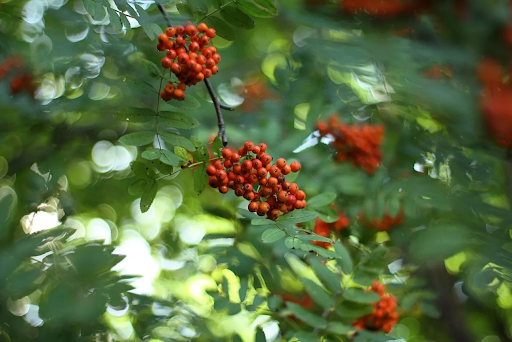This week is National Tree Week, the UK's largest annual tree celebration, and we're going to celebrate 4 trees that can make a big impact in your garden or small park. Planting native trees and shrubs is such a vital aspect of rewilding, especially in Britain, where local flora plays an integral role in sustaining the ecosystem.
So here's our fab 4. Each offer unique contributions that benefit birds, insects, and mammals, creating a thriving, interconnected habitat for wildlife:
Rowan (Sorbus aucuparia) or mountain ash . Known for its striking red berries that appear in late summer and early autumn. These berries are highly nutritious and attract a range of bird species, including fieldfares and waxwings, which rely on them for energy during migration. In addition to benefiting birds, the rowan’s blossoms support various pollinators, enhancing biodiversity. Its bright red berries are a welcome sight on a grey, misty Autumn morning.

Hawthorn (Crataegus monogyna). Another crucial native shrub that supports British wildlife. In spring, it produces clusters of white flowers rich in nectar, attracting pollinators like bees and butterflies. These pollinators are fundamental for the health of broader plant communities, aiding in the pollination of various native and garden plants.
The English oak (Quercus robur). Perhaps the most significant native tree in Britain. It serves as a keystone species, hosting more than 2,300 species of wildlife. LettsSafari parks boast dozens of large, ancient oak trees. We planted hundreds of diverse young oak trees in Dawlish Park alone - now they are fast growing, hormonal teenagers!

Hazel (Corylus avellana). A versatile native shrub that offers both food and habitat. Its catkins, appearing in early spring, are one of the first pollen sources for bees, giving them essential nourishment after winter. By late summer, hazelnuts provide a rich food supply for mammals such as dormice and red squirrels, which rely on these nuts for fat reserves. The dense, multi-stemmed growth of hazel also creates excellent nesting sites for birds.
The importance of planting native species lies in their evolved relationships with local wildlife. These plants are adapted to the local climate and soil, making them more resilient and beneficial compared to non-native species.
LettsSafari regularly reviews the various tree options available for smaller-scale rewilding to help you make the best choices. By incorporating native trees, shrubs and wild grasses into our gardens and parks, we help build a self-sustaining ecosystem where each species contributes to the overall health and balance. This practice is essential not only for enhancing biodiversity but also for maintaining ecosystem services such as pollination, seed dispersal, and habitat creation.
Support our rewilding parks, get exclusive content of our projects and even receive expert tips to transform your garden into a wildlife haven.
🌱 For every 10 new subscribers we plant a tree a year.
🦔 For every 100, we release an endangered animal.
🌳 And for every 10,000 we create a new rewilding safari park a year!
Make A Difference: Together We Can Rewild To Tackle Climate Change.